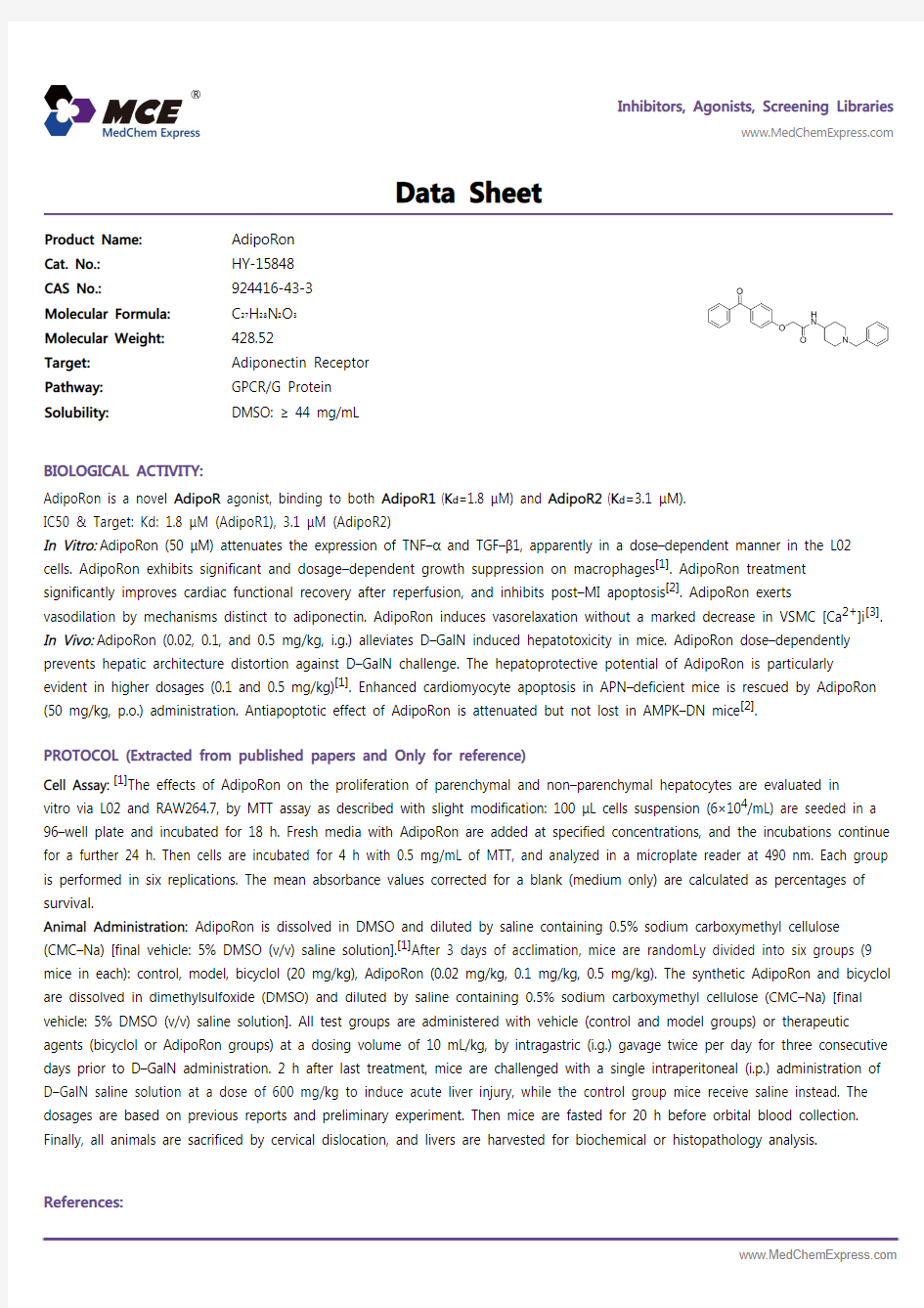AdipoRon_DataSheet_MedChemExpress


Inhibitors, Agonists, Screening Libraries
https://www.360docs.net/doc/d02725391.html, Data Sheet
BIOLOGICAL ACTIVITY:
AdipoRon is a novel AdipoR agonist, binding to both AdipoR1 (K d =1.8 μM) and AdipoR2 (K d =3.1 μM).
IC50 & Target: Kd: 1.8 μM (AdipoR1), 3.1 μM (AdipoR2)
In Vitro: AdipoRon (50 μM) attenuates the expression of TNF–α and TGF–β1, apparently in a dose–dependent manner in the L02cells. AdipoRon exhibits significant and dosage–dependent growth suppression on macrophages [1]. AdipoRon treatment
significantly improves cardiac functional recovery after reperfusion, and inhibits post–MI apoptosis [2]. AdipoRon exerts
vasodilation by mechanisms distinct to adiponectin. AdipoRon induces vasorelaxation without a marked decrease in VSMC [Ca 2+]i [3].In Vivo: AdipoRon (0.02, 0.1, and 0.5 mg/kg, i.g.) alleviates D–GalN induced hepatotoxicity in mice. AdipoRon dose–dependently prevents hepatic architecture distortion against D–GalN challenge. The hepatoprotective potential of AdipoRon is particularly evident in higher dosages (0.1 and 0.5 mg/kg)[1]. Enhanced cardiomyocyte apoptosis in APN–deficient mice is rescued by AdipoRon
(50 mg/kg, p.o.) administration. Antiapoptotic effect of AdipoRon is attenuated but not lost in AMPK–DN mice [2].PROTOCOL (Extracted from published papers and Only for reference)
Cell Assay:[1]The effects of AdipoRon on the proliferation of parenchymal and non–parenchymal hepatocytes are evaluated in
vitro via L02 and RAW264.7, by MTT assay as described with slight modification: 100 μL cells suspension (6×104/mL) are seeded in a 96–well plate and incubated for 18 h. Fresh media with AdipoRon are added at specified concentrations, and the incubations continue for a further 24 h. Then cells are incubated for 4 h with 0.5 mg/mL of MTT, and analyzed in a microplate reader at 490 nm. Each group is performed in six replications. The mean absorbance values corrected for a blank (medium only) are calculated as percentages of survival.
Animal Administration: AdipoRon is dissolved in DMSO and diluted by saline containing 0.5% sodium carboxymethyl cellulose
(CMC–Na) [final vehicle: 5% DMSO (v/v) saline solution].[1]After 3 days of acclimation, mice are randomLy divided into six groups (9mice in each): control, model, bicyclol (20 mg/kg), AdipoRon (0.02 mg/kg, 0.1 mg/kg, 0.5 mg/kg). The synthetic AdipoRon and bicyclol are dissolved in dimethylsulfoxide (DMSO) and diluted by saline containing 0.5% sodium carboxymethyl cellulose (CMC–Na) [final vehicle: 5% DMSO (v/v) saline solution]. All test groups are administered with vehicle (control and model groups) or therapeutic
agents (bicyclol or AdipoRon groups) at a dosing volume of 10 mL/kg, by intragastric (i.g.) gavage twice per day for three consecutive days prior to D–GalN administration. 2 h after last treatment, mice are challenged with a single intraperitoneal (i.p.) administration of D–GalN saline solution at a dose of 600 mg/kg to induce acute liver injury, while the control group mice receive saline instead. The dosages are based on previous reports and preliminary experiment. Then mice are fasted for 20 h before orbital blood collection.Finally, all animals are sacrificed by cervical dislocation, and livers are harvested for biochemical or histopathology analysis.References:
Product Name:
AdipoRon Cat. No.:
HY-15848CAS No.:
924416-43-3Molecular Formula:
C 27H 28N 2O 3Molecular Weight:
428.52Target:
Adiponectin Receptor Pathway:
GPCR/G Protein Solubility:
DMSO: ≥ 44 mg/mL
[1]. Wang Y, et al. Hepatoprotective effects of AdipoRon against d–galactosamine–induced liver injury in mice. Eur J Pharm Sci. 2016 Aug 9;93:123–131.
[2]. Zhang Y, et al. AdipoRon, the first orally active adiponectin receptor activator, attenuates postischemic myocardial apoptosis through both
AMPK–mediated and AMPK–independent signalings. Am J Physiol Endocrinol Metab. 2015 Aug 1;309(3):E275–82.
[3]. Hong K, et al. Adiponectin Receptor Agonist, AdipoRon, Causes Vasorelaxation Predominantly Via a Direct Smooth Muscle Action. Microcirculation. 2016 Apr;23(3):207–20.
Caution: Product has not been fully validated for medical applications. For research use only.
Tel: 609-228-6898 Fax: 609-228-5909 E-mail: tech@https://www.360docs.net/doc/d02725391.html,
Address: 1 Deer Park Dr, Suite Q, Monmouth Junction, NJ 08852, USA
